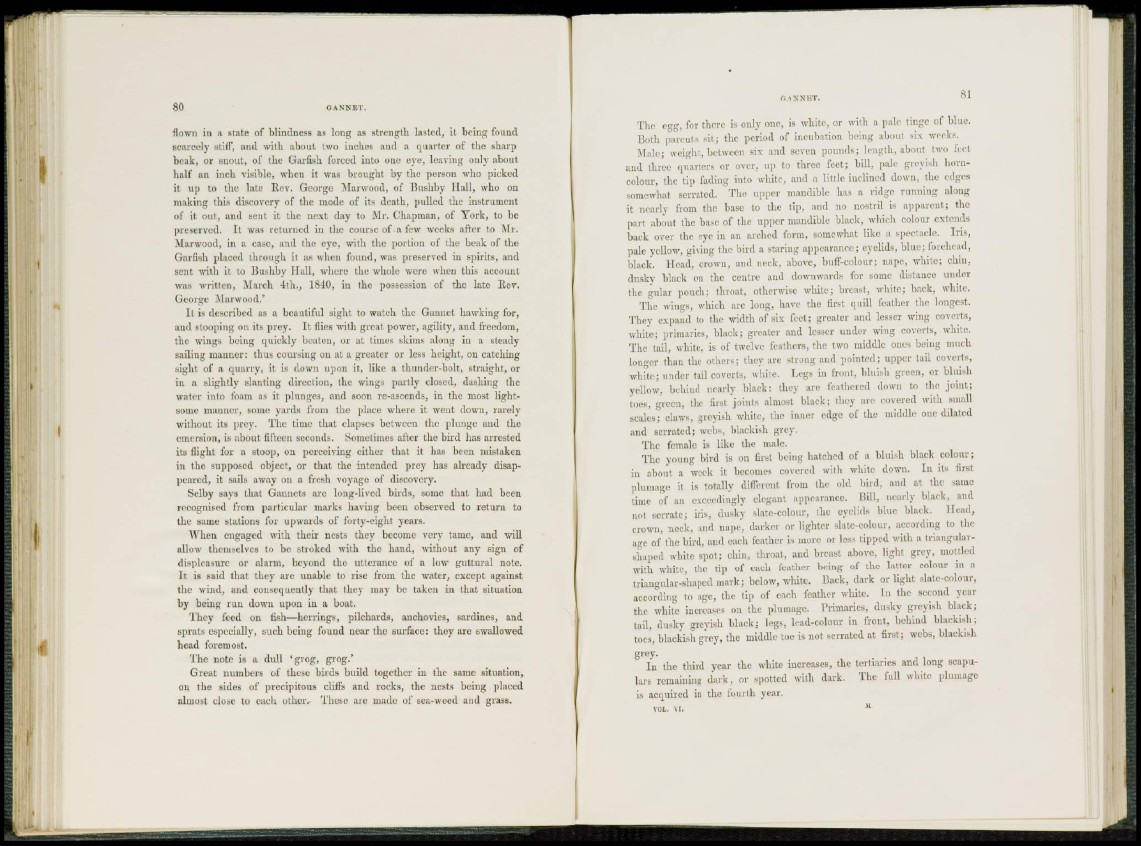
flown in a state of blindness as long as strength lasted, it being found
scarcely stiff, and with about two inches and a quarter of the sharp
beak, or snout, of the Garfish forced into one eye, leaving only about
half an inch visible, when it was brought by the person who picked
it up to the late Rev. George Marwood, of Bushby Hall, who on
making this discovery of the mode of its death, pulled the instrument
of it out, and sent it the next day to Mr. Chapman, of York, to be
preserved. It was returned in the course of a few weeks after to Mr.
Marwood, in a case, and the eye, with the portion of the beak of the
Garfish placed through it as when found, was preserved in spirits, and
sent with it to Bushby Hall, where the whole were when this account
was written, March 4th., 1840, in the possession of the late Rev.
George Marwood.'
I t is described as a beautiful sight to watch the Gaimct hawking for,
and stooping on its prey. It flies with great power, agility, and freedom,
the wings being quickly beaten, or at times skims along in a steady
sailing manner: thus coursing on at a greater or less height, on catching
sight of a quarry, it is down upon it, like a thunder-bolt, straight, or
in a slightly slanting direction, the wings partly closed, dashing the
water into foam as it plunges, and soon re-ascends, in the most lightsome
manner, some yards from the place where it went down, rarely
without its prey. The time that elapses between the plunge and the
emersion, is about fifteen seconds. Sometimes after the bird has arrested
its flight for a stoop, on perceiving either that it has been mistaken
in the supposed object, or that the intended prey has already disappeared,
it sails away on a fresh voyage of discovery.
Selby says that Ganncts are long-lived birds, some that had been
recognised from particular marks having been observed to return to
the same stations for upwards of forty-eight years.
When engaged with their nests they become very tame, and will
allow themselves to be stroked with the hand, without any sign of
displeasure or alarm, beyond the utterance of a low guttural note.
I t is said that they are unable to rise from the water, except against
the wind, and consequently that they may be taken in that situation
by being run down upon in a boat.
They feed on fish—herrings, pilchards, anchovies, sardines, and
sprats especially, such being found near the surface: they are swallowed
head foremost.
The note is a dull cgrog, grog.5
Great numbers of these birds build together in the same situation,
on the sides of precipitous cliffs and rocks, the nests being placed
almost close to each other.- These are made of sea-weed and grass.
a ANNET. S I
The egg, for there is only one, is white, or with a pale tinge of blue.
Both parents sit; the period of incubation being about six weeks.
Male; weight, between six and seven pounds; length, about two feet
ami three quarters or over, up (o three feet; bill, pale greyish horncolour,
the tip fading into white, and a little inclined down, the edges
somewhat serrated. The upper mandible has a ridge running along
it nearly from the base to the tip, and no nostril is apparent; the
part about the base of the upper mandible black, which colour extends
back over the eye in an arched form, somewhat like a spectacle. Iris,
pale yellow, giving the bird a staring appearance; eyelids, blue; forehead,
black. Head, crown, and neck, above, buff-colour; nape, white; chin,
dusky black on the centre and downwards for some distance under
the gular pouch; throat, otherwise white; breast, white; back, white.
The wings, which are long, have the first quill feather the longest.
They expand to the width of six feet; greater and lesser wing coverts,
white; primaries, black; greater and lesser under wing coverts, white.
The tail, white, is of twelve feathers, the two middle ones being much
longer than the others; they arc strong and pointed; upper tail coverts,
white; under tail coverts, while. Legs in front, bluish green, or bluish
yellow, behind nearly black: they are feathered down to the joint;
toes, green, the first joints almost black; they are covered with small
scales; claws, greyish white, the inner edge of the middle one dilated
and serrated; webs, blackish grey.
The female is like the male.
The young bird is on first being hatched of a bluish black colour;
in about a week it becomes covered with white down. In its first
plumage it is totally different from the old bird, and at the same
time of an exceedingly elegant appearance. Bill, nearly black, and
not serrate; iris, dusky slate-colour, the eyelids blue black. I lead,
crown, neck, and nape, darker or lighter slate-colour, according to the
age of the bird, and each feather is more or less tipped with a triangularshaped
white spot; chin, throat, and breast above, light grey, mottled
with white, the tip of each feather being of the latter colour in a
triangular-shaped mark; below, white. Back, dark or light slate-colour,
according to age, the tip of each feather white. In the second year
the white increases on the plumage. Primaries, dusky greyish black;
tail, dusky greyish black; legs, lead-colour in front, behind blackish;
toes, blackish grey, the middle toe is not serrated at first; webs, blackish
I n the third year the white increases, the tcrtiaries and long scapulars
remaining dark, or spotted with dark. The full white plumage
is acquired in the fourth year.
VOL. VI. 11